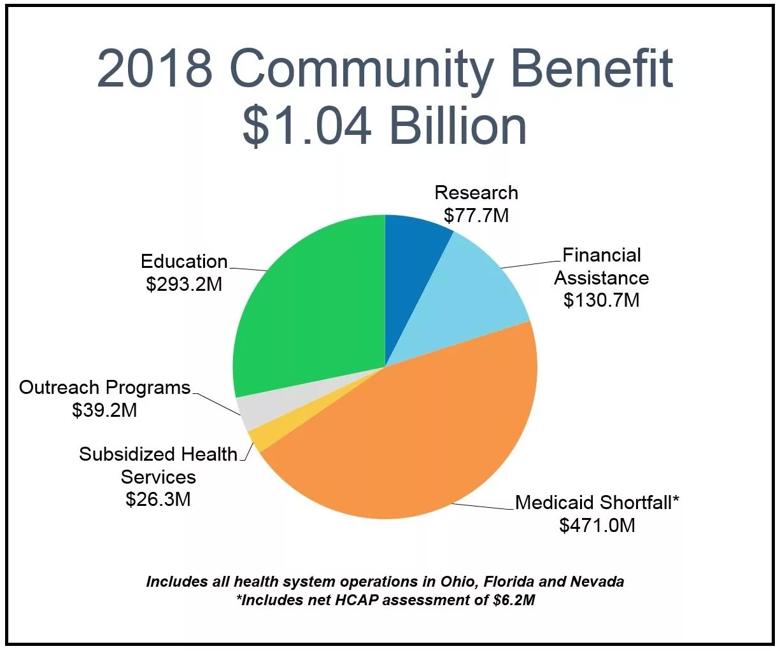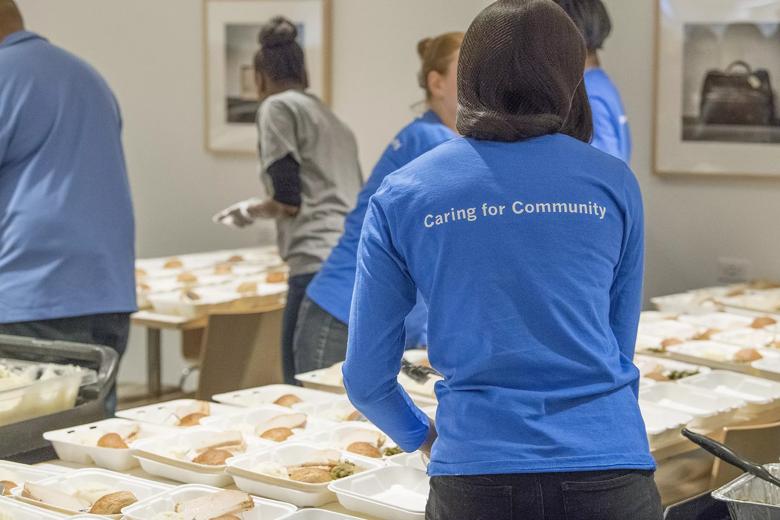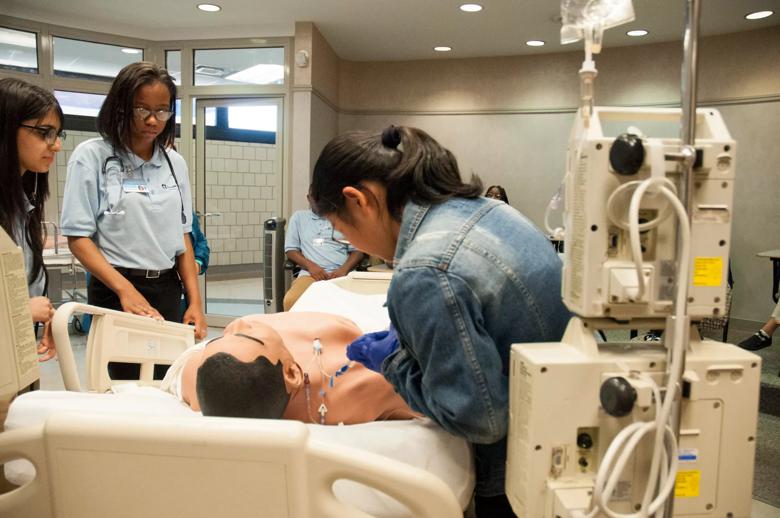Total includes operations in Ohio, Nevada and Florida; Highest in Cleveland Clinic’s history
Content is property of Cleveland Clinic and for news media use only.

As part of its continuing commitment to promote access to healthcare and healthy behaviors in our communities, Cleveland Clinic invested more than $1 billion in community benefit in 2018, the most in the health system’s history.

Cleveland Clinic’s total community benefit increased 6% to $1.04 billion in 2018 from $981.4 million in 2017. The figures reflect all health system operations for Cleveland Clinic in Ohio, Florida, and Nevada.
Community benefit is a measure of a hospital’s investment in its community through outreach programs, medical education, research, financial assistance, coverage of Medicaid shortfalls, and subsidized care.
“We want every community we serve to be the healthiest community possible,” said Cleveland Clinic CEO and President Tom Mihaljevic, M.D. “Our community benefit demonstrates our focus on creating a healthier population. Caring for patients requires that we care for our communities everywhere we are.”
As a nonprofit hospital system, Cleveland Clinic is a community asset with no owners, investors or stockholders. Any and all extra funds from operations are invested back into the health system to support patient care, research, education, and long-standing charitable efforts.

Community benefit data is calculated in accordance with IRS Form 990 reporting guidelines and includes activities that improve access to health services, enhance public health, advance general knowledge and relieve government burden. The primary categories for assessing community benefit include:
Cleveland Clinic’s financial assistance – free or discounted medical care provided to those patients unable to pay some or all of their bills – increased 19% from 2017 to 2018.
Cleveland Clinic provides free or discounted care to patients with incomes up to 400 percent of the federal poverty level and covers both hospital care and our employed physician services.
Cleveland Clinic experienced a 5.1% increase in Medicaid Shortfall from 2017 to 2018. Funded by state and federal governments, Medicaid provides healthcare coverage for low-income families and individuals. In many states, including Ohio, Medicaid payments have not been sufficient to cover the costs of treating Medicaid beneficiaries. In 2018, our Medicaid costs included $6.2 million net contribution to Ohio’s Hospital Care Assurance Program (HCAP).
Cleveland Clinic’s subsidized health services – which increased approximately 4% from 2017 to 2018 – include pediatric programs, psychiatric/behavioral health programs, obstetrics services, chronic disease management and outpatient clinics. Excluding financial assistance costs and Medicaid shortfalls, Cleveland Clinic provided subsidized health services in 2018 at a cost of $26.3 million.
Cleveland Clinic outreach programs align with the community needs identified in the hospitals’ Community Health Needs Assessments, with a focus on community health, specifically chronic disease prevention and management, infant mortality, opioid crisis and socioeconomic concerns. In 2018, these costs increased 4.5% compared to 2017.
Examples include:
Cleveland Clinic education initiatives cover a wide range of medical education programs, including accredited training programs for residents, physicians, nurses and allied health professionals. By educating medical professionals, we ensure that the public is receiving the highest standard of medical care and will have highly trained health professionals to care for them in the future. For 2018, Cleveland Clinic’s total expenditure in support of education was $298.2 million, partially offset by $5 million in grants and other external funding, resulting in a net cost of $293.2 million.
Research into diseases and cures is an investment in society’s long-term health. From a community benefit standpoint, research includes basic, clinical and community health research, as well as studies on healthcare delivery. With nearly 1,500 researchers and support personnel in 175 laboratories in 12 departments, Lerner Research Institute is one of the largest research institutes in the nation. In 2018, Cleveland Clinic’s total expenditure in support of research was $243.4 million, offset by $165.7 million in grants and other external funding, resulting in a net cost of $77.7 million.
“Our community benefit is just one measure of Cleveland Clinic’s commitment to our neighbors,” Dr. Mihaljevic said. “In addition to providing healthcare services, we support communities economically by hiring locally and also participate in community service through paid-time-off volunteer initiatives. We are intent on giving back, uplifting our neighborhoods, and remaining a critical part of our communities’ social fabric.”
Read or download the entire community benefit report here.

Cleveland Clinic caregivers prepared Thanksgiving meals for distribution in the Fairfax and Hough neighborhoods.

Cleveland Clinic – in partnership with Cleveland State University and Kent State University – offers the NEOREMA (Northeast Ohio Research Education Medicine Alliance) Experience, a four-week summer program for high school sophomores from historically under-represented groups within the biomedical sciences.

In 2018, Cleveland Clinic invested $243.4 million in research projects.

Since 2003, Cleveland Clinic has hosted the Minority Men’s Health Fair, offering free tests and screenings for prostate cancer, hypertension, heart disease, skin cancer, diabetes and other conditions. More than 16,000 men have attended the health fair and have undergone a total of more than 48,000 screenings.
Cleveland Clinic is a nonprofit multispecialty academic medical center that integrates clinical and hospital care with research and education. Located in Cleveland, Ohio, it was founded in 1921 by four renowned physicians with a vision of providing outstanding patient care based upon the principles of cooperation, compassion and innovation. Cleveland Clinic has pioneered many medical breakthroughs, including coronary artery bypass surgery and the first face transplant in the United States. Cleveland Clinic is consistently recognized in the U.S. and throughout the world for its expertise and care. Among Cleveland Clinic’s 82,600 employees worldwide are more than 5,786 salaried physicians and researchers, and 20,700 registered nurses and advanced practice providers, representing 140 medical specialties and subspecialties. Cleveland Clinic is a 6,728-bed health system that includes a 173-acre main campus near downtown Cleveland, 23 hospitals, 280 outpatient facilities, including locations in northeast Ohio; Florida; Las Vegas, Nevada; Toronto, Canada; Abu Dhabi, UAE; and London, England. In 2024, there were 15.7 million outpatient encounters, 333,000 hospital admissions and observations, and 320,000 surgeries and procedures throughout Cleveland Clinic’s health system. Patients came for treatment from every state and 112 countries. Visit us at clevelandclinic.org. Follow us at x.com/CleClinicNews. News and resources are available at newsroom.clevelandclinic.org.
Editor’s Note: Cleveland Clinic News Service is available to provide broadcast-quality interviews and B-roll upon request.